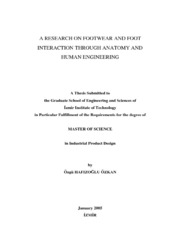Please use this identifier to cite or link to this item:
https://hdl.handle.net/11147/3372Full metadata record
| DC Field | Value | Language |
|---|---|---|
| dc.contributor.advisor | Seçkin, Yavuz | - |
| dc.contributor.author | Hafızoğlu Özkan, Özgü | - |
| dc.date.accessioned | 2014-07-22T13:51:24Z | - |
| dc.date.available | 2014-07-22T13:51:24Z | - |
| dc.date.issued | 2005 | - |
| dc.identifier.uri | http://hdl.handle.net/11147/3372 | - |
| dc.description | Thesis (Master)--Izmir Institute of Technology, Industrial Design, Izmir, 2005 | en_US |
| dc.description | Includes bibliographical references (leaves: 144) | en_US |
| dc.description | Text in English; Abstract: Turkish and English | en_US |
| dc.description | xix, 155 leaves | en_US |
| dc.description.abstract | The main purpose of this thesis is to examine the footwear design from the human engineering point of view. Traditionally, the concern of the designer has mostly concerned to the form in footwear design field, but user and environment-conscious designer should think about the value and compatibility of the footwear to experience comfort, performance, safety and satisfaction during use. To develop the "Footwear Design" in a human centered way, the designer should be able to synthesis the datum of design that had been analyzed from the "Human Engineering. point of view and able to assess or evaluate which design solution is better and compatible for human mobility.The basic aim of this study is to help designers to comprehend the conceptual infrastructure of footwear and foot interaction such as anatomy, anthropometry, biomechanics, physical characteristics, and ergonomics.One of the main purposes of chapter 2 is to examine the every aspect of industrial product design from the human engineering point of view and in this context, the definition of footwear design elements.In chapter 3, the foot structure is analyzed from the anatomical, morphological and biomechanical point of view with respect to foot-footwear interaction and human engineering and the Failings of modern footwear design and its discordant features and detrimental manner for the foot natural characteristics are examined to attract the attention of the designers for perceiving the responsibility that they have.In chapter 4, there are two main sections which contain fundamental design criteria through foot- footwear interaction and ergonomic considerations. Then the innovative and affirmative characteristic of modern footwear design is analyzed to encourage the designer to design the better products to drive the footwear design to new heights with respect to human nature using appropriate materials and appropriate forms. | en_US |
| dc.language.iso | en | en_US |
| dc.publisher | Izmir Institute of Technology | en_US |
| dc.rights | info:eu-repo/semantics/openAccess | en_US |
| dc.subject.lcc | TS990 .H138 2005 | en |
| dc.subject.lcsh | Footwear--Design | en |
| dc.subject.lcsh | Design--Human factors | en |
| dc.subject.lcsh | Shoes--Design | en |
| dc.subject.lcsh | Footwear--Standards | en |
| dc.title | A Research on Footwear and Foot Interaction Through Anatomy and Human Engineering | en_US |
| dc.type | Master Thesis | en_US |
| dc.institutionauthor | Hafızoğlu Özkan, Özgü | - |
| dc.department | Thesis (Master)--İzmir Institute of Technology, Industrial Design | en_US |
| dc.relation.publicationcategory | Tez | en_US |
| dc.identifier.wosquality | N/A | - |
| dc.identifier.scopusquality | N/A | - |
| item.openairecristype | http://purl.org/coar/resource_type/c_18cf | - |
| item.languageiso639-1 | en | - |
| item.openairetype | Master Thesis | - |
| item.grantfulltext | open | - |
| item.fulltext | With Fulltext | - |
| item.cerifentitytype | Publications | - |
| Appears in Collections: | Master Degree / Yüksek Lisans Tezleri Sürdürülebilir Yeşil Kampüs Koleksiyonu / Sustainable Green Campus Collection | |
Files in This Item:
| File | Description | Size | Format | |
|---|---|---|---|---|
| T000429.pdf | MasterThesis | 14.31 MB | Adobe PDF |  View/Open |
CORE Recommender
Page view(s)
38,790
checked on Mar 31, 2025
Download(s)
584
checked on Mar 31, 2025
Google ScholarTM
Check
Items in GCRIS Repository are protected by copyright, with all rights reserved, unless otherwise indicated.